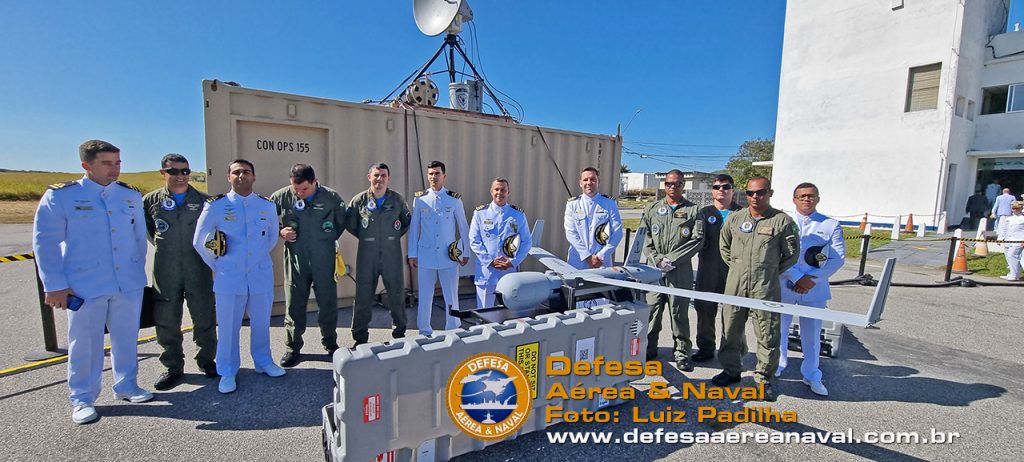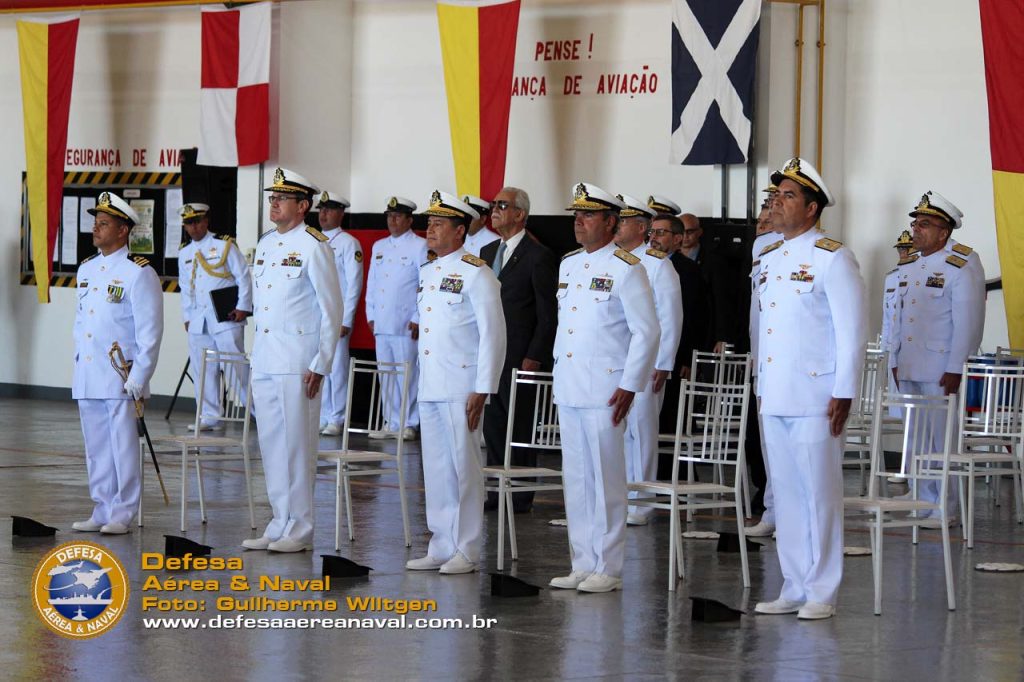
Brazilian Navy activates its first Squadron of Remotely Piloted Aircraft
Translated from Portuguese – Original Article Here.
Naval Aviation began the 5th phase of its 106-year history, to be completed on August 23, by activating the 1st Squadron of Remotely Piloted Aircraft (QE-1), on July 5, 2022, being named as the first Commander Frigate Captain Fabio Bernardo Nunes.
The military ceremony took place at the São Pedro da Aldeia Naval Air Base and was attended by the Navy Commander, Fleet Admiral Almir Garnier Santos, the Naval Operations Commander, Fleet Admiral Marcos Sampaio Olsen, the General Director of Navy Material, Fleet Admiral José Augusto Vieira da Cunha de Menezes, Fleet Commander-in-Chief, Vice Admiral Arthur Fernando Bettega Correa, Naval Air Force Commander, Rear Admiral José Augusto Augusto José da Silva Fonseca Junior, in addition to civil and military authorities and former Commanders of the Naval Air Force.
In his words, AE Garnier highlighted the importance of activating the newest Naval Aviation Military Organization as “Today is a historic day for the Brazilian Navy and the importance is related to the fact that reveals our future” and completed “And so are the unmanned aerial vehicles whose cornerstone the Navy is laying today, the result of an effort made by generations that preceded us”.
AE Garnier highlighted the importance of EsqdQE-1 to develop doctrines, train and qualify the MB to use in the future other types of SARP-E, more capable and necessary, for the protection of the Blue Amazon.
Shortly after the ceremony, a demonstration was held for the Navy Commander, with the launch and recall of the RQ-1 ScanEagle N-8001.
The Navy Commander can also follow, from inside the control module, a demonstration of the capabilities of the RQ-1 ScanEagle, during the demonstration flight in the area close to the São Pedro da Aldeia Naval Air Complex.
Officially activated on July 5, 2022, Harpia was chosen, one of the largest birds of prey in the world, found in Brazil in the Amazon and Atlantic Forest region, to represent the QE-1, which today has 37 military personnel, being ten officers (eight pilots trained at the manufacturer) and 27 enlisted men, all from the different fixed and rotary wing squadrons.
The QE-1 has six Embedded Remotely Piloted Aircraft Systems (SARP-E), designated RQ-1 ScanEagle with registration numbers N-8001 to N-8006, two launchers (one on-board and one on land) and two recoil systems. The Esquadrão Harpia shares the “ALFA” hangar of Esquadrão HA-1, located at the São Pedro da Aldeia Naval Air Base (BAeNSPA).
By the end of this year, the necessary systems will be installed on the Frigate Independência (F 44) and on the Amazon Ocean Patrol Vessel (P 120), with the first embarked operation expected to take place in December 2022.
Read original article on Defesa Area Naval. Portuguese version follows:

Marinha do Brasil ativa seu primeiro Esquadrão de Aeronaves Remotamente Pilotadas
A Aviação Naval iniciou a 5ª fase da sua história de 106 anos, a completar no próximo dia 23 de agosto, ao ativar o 1º Esquadrão de Aeronaves Remotamente Pilotadas (QE-1), no dia 05 de julho de 2022, sendo nomeado como primeiro Comandante o Capitão de Fragata Fabio Bernardo Nunes.
A cerimônia militar ocorreu na Base Aérea Naval de São Pedro da Aldeia e contou com as presenças do Comandante da Marinha, Almirante de Esquadra Almir Garnier Santos, do Comandante de Operações Navais, Almirante de Esquadra Marcos Sampaio Olsen, do Diretor Geral de Material de Marinha, Almirante de Esquadra José Augusto Vieira da Cunha de Menezes, do Comandante em Chefe da Esquadra, Vice-Almirante Arthur Fernando Bettega Correa, do Comandante da Força Aeronaval, Contra Almirante José Augusto Augusto José da Silva Fonseca Junior, além de autoridades civis e militares e ex-Comandantes da Força Aeronaval.
Em suas palavras, o AE Garnier ressaltou a importância da ativação da mais nova Organização Militar da Aviação Naval como “Hoje é um dia histórico para a Marinha do Brasil e a importância está relacionada ao fato que descortina o nosso futuro” e completou “E assim são os veículos aéreos não tripulados cuja a pedra fundamental, a Marinha está colocando hoje, fruto de um esforço despendido pelas gerações que nos antecederam”.
O AE Garnier ressaltou a importância do EsqdQE-1 para desenvolver as doutrinas, capacitar e qualificar a MB a utilizar no futuro outros tipos de SARP-E, mais capazes e necessários, para a proteção da Amazônia Azul.
Logo após a cerimônia, foi realizada uma demonstração para o Comandante da Marinha, com o lançamento e recolhimento do RQ-1 ScanEagle N-8001.
O Comandante da Marinha também pode acompanhar, de dentro do módulo de controle, uma demonstração das capacidades do RQ-1 ScanEagle, durante o voo de demonstração na área próxima ao Complexo Aeronaval de São Pedro da Aldeia.
Oficialmente ativado no dia 05 de julho de 2022, foi escolhida a Harpia, uma das maiores aves de rapina do mundo, encontrada no Brasil na região da Amazônia e Mata Atlântica, para representar o QE-1, que hoje conta com 37 militares, sendo dez oficiais (oito pilotos formados no fabricante) e 27 praças, todos oriundos dos diversos Esquadrões de asa-fixa e rotativa.
O QE-1 possui seis Sistemas de Aeronaves Remotamente Pilotadas Embarcado (SARP-E), designadas RQ-1 ScanEagle com matrículas N-8001 a N-8006, dois lançadores (um embarcado e um terrestre) e dois sistemas de recolhimento. O Esquadrão Harpia compartilha o hangar “ALFA” do Esquadrão HA-1, localizado na Base Aérea Naval de São Pedro da Aldeia (BAeNSPA).
Até o final deste ano, será realizada a instalação dos sistemas necessários na Fragata Independência (F 44) e no Navio Patrulha Oceânico Amazonas (P 120), com previsão da primeira operação embarcada ocorrer em dezembro de 2022.
Related News
Australian Army commences training on Integrator UAS
June 23, 2022Read More
Latest News
NAVFAC Completes Construction Of Royal Thai Navy Facility In 100 Days
Naval Facilities Engineering Systems Command Thailand completed construction of an UAS Operations Support Facility on June 9
Read More »Australian Army commences training on Integrator UAS
Insitu Pacific has announced it has commenced the first pilot’s course for the Australian Army’s new Integrator uncrewed aircraft system
Read More »The Australian Army will receive two dozen Integrator UAVs sourced from Australia
Work on Integrator tactical UAVs for the Australian Army under Project Land 129 Phase 3 is ‘well under way’…
Read More »